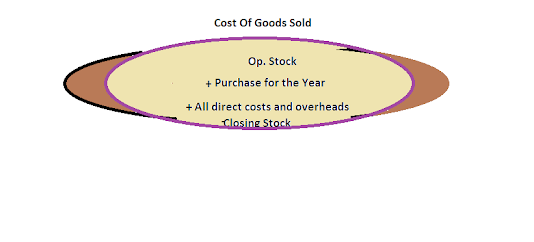How To Accounts Cost Of Goods Sold (COG) in Profit & Loss (P/L) (Income Statement)
Ok Guys, To continue with the "Accounting Basics", after having discussion on Sales Revenue. Let’s move on towards the second item on the Income Statement, COGS. I think this article is going to be long coz there are several inner branch of the COGS component which needs to be discussed in order to fully understand what COGS is?????
By virtue of its name, COGS is the total cost of goods that has been sold for the particular fiscal year. There are usually there components which will constitute the COGS:
1. Opening Inventory (Opening Stock)
2. Purchase for the year
3. Closing Inventory (Closing Stock)
Now, Let’s go into details on how to accounts:
Opening Stock (Opening Inventory):
Opening Stock within
the COGS component refers to the inventory which is at the opening of the
fiscal year and that will be same as the closing inventory of the previous
fiscal year. Suppose, if In Year 2019 the closing month is December 31st,
the remaining stock at the end of the December 31st will be the
opening stock for the year 2020. Usually fiscal year always consists of 12
months i.e. a year, so the opening day of the year will be January 1st
and the Opening Balance of the New Year, that is 2020 , is same as that of the
closing balance of the Previous Year i.e. 2019. It is needed to calculate the COGS, a P/L item and the Closing
Inventory, a balance sheet item.
Purchase for the year:
By virtue of its name,
Purchase in COGS is the total amount of Gross Purchase made for the year less any
sort of purchase return and discount, which then actually becomes the Net
Purchase for the year. Purchase return, is always the return of any purchased
goods to the supplier because of different reasons and the discount on purchase
refers to the discount that has been received because of various reason like
bulk purchase.
Another thing to consider is the freight and transportation charge
pertaining to the purchases of the raw material. It is the general principle in
accounting that the freight charge and the transportation charge is to be
included within the purchase cost itself. It is within the general principle of
the accounting that the raw material is valued
It is needed to calculate the COGS, a P/L item and the Closing
Inventory, a balance sheet item.
Closing stock (Closing Inventory):
This refers to the
total remaining inventory at the end of any fiscal year. This requires the
actual count of the inventory level and can be time consuming exercise in
various organizations where they lack smart inventory control system. This actual remaining inventory for the
year is the ultimate item that goes to the Current Asset section of the Balance
Sheet and is a balance sheet item and is needed to calculate the COGS in Income
Statement.
What Direct labor charges is?
It is the charge of the workforce that is involved in the manufacturing
unit directly in bringing the finished goods (i.e. the product that the company
sells) from the raw material that is purchased. Simply, it is the charge of the
workforce, mostly calculated in hourly basis.
Another important item to understand the COGS in manufacturing
environment is the Direct Overhead Expense and to understand the Direct
Overhead Expenses we need to understand what actually is Overhead Expense???
Please follow through the link to understand what Overhead expense actually is ???
In Short, direct Overheads are overheads which relates to the production process
of the goods like factory rents, electricity charges allocated for the uses of
machines etc.
Actually, there are other headings that can constitute a component of
COGS, it actually varies according to the nature of industry in which the
company operates like, some companies like AUDI AG and BMW AG incorporates
their warranty claims in COGS. Anyway, the basics are described above and if
you are studying particular industry then you can follow along with the company
specific financial statements and get information from “notes to accounts”
section of the annual reports.
This is all to conclude about COGS (accounting basics) on how to accounts.
If you like the article then, please consider subscribing.





0 Comments